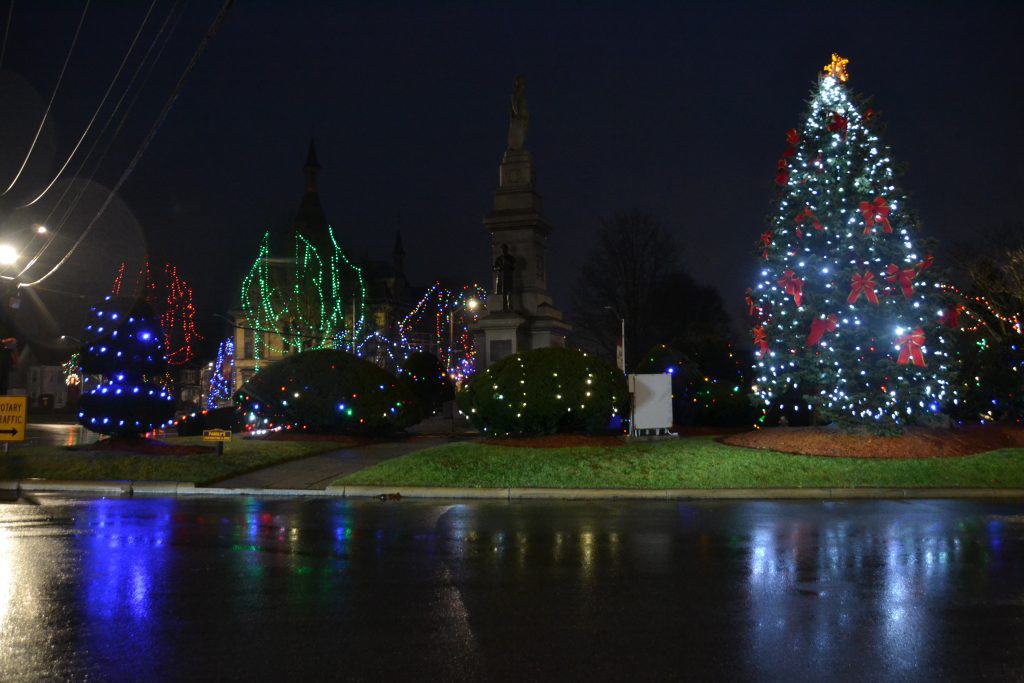Here’s what’s blooming in town this week to make your walks more enjoyable
By Laura Eisener
The year is winding down and the last full moon will be here the day after Christmas, on December 26. Known as the Full Cold Moon, it remains to be seen whether the temperatures live up to the name, since much of this month has been warmer than usually expected for the time of year. Perhaps it’s the reason Christmas seems to have crept up on us early. There are plenty of homes where the occupants have found time to decorate for the season, and it is worth looking around town at all the brilliance every evening. On Gilway Road off Lynn Fells Parkway, Julie Bentivegna’s house is resplendent with a festive atmosphere – several decorated trees can be seen through the rounded windows, and plenty of energy is shown by all nine reindeer pulling Santa’s sleigh across her lawn!
One hundred years ago, on December 24, 1923, Calvin Coolidge lit the first national Christmas tree on the grounds of the White House, a tradition which has been followed ever since, although the lighting now takes place earlier in the season. This year’s tree, a Norway spruce (Picea abies) was lit November 30. The first tree was a balsam fir (Abies balsamea) from Vermont, Coolidge’s home state. It was 48 feet tall and was lit with 2,500 electric lights in red, green and white. Some earlier presidents had Christmas trees indoors, but this was the first outdoor one, displayed for the public.
Balsam fir is the most popular tree species in New England for a Christmas tree, famed for its fragrance. The soft needles are green on the upper surface and silvery on the underside. Most wreaths in New England are also made of balsam fir, including those decorated by the Garden club members earlier this month and the wreaths laid on Veterans’ graves at Riverside this past Saturday. This tree prefers slightly colder areas than Saugus but grows very well in the northern New England states and Canada. The Christmas carol “O Tannenbaum” was originally a folk song unconnected to Christmas but was a song in praise of the evergreen fir tree, whose leaves stayed faithfully green all year. The song was written in the 1820’s, and the popularity of Christmas trees increased around this time, and gradually translated versions of the song began to emphasize Christmas trees rather than a wild fir tree growing in the woods. The European silver fir (Abies alba) was probably the species that inspired the song, although there are also some other fir species that are native to Eurasia.
In North America, the sap of balsam fir was used by native Americans as an antiseptic and as a salve for injuries. This is where the species epithet balsamea, which means a balm or soothing ointment, came from. A tea was sometimes made from steeping the fresh branches to ease symptoms of colds and coughs.
Some species of holly are also closely associated with Christmas and used for wreaths, garlands and other decorations. Holly is a broadleaf evergreen – unrelated to needle-leaved trees like most conifers. We usually picture them with spiny-edged foliage, although there are many holly species that do not have this characteristic. English holly (Ilex aquifolia) is the species originally used in decorating and mentioned in a few traditional Christmas songs. One especially striking variety is silver-edged holly (Ilex aquifolia argentea marginata) with spiny leaves that are green with white edges. English holly is a fairly common tree in the English woods, growing 40′ high or more. More often planted in New England gardens is the shrubby hybrid blue holly (Ilex meservae), which has glossy blue-green leaves and only grows to 10′. Very similar to the English holly is American holly (Ilex opaca), which also becomes a tree and can be found growing wild on Cape Cod, Connecticut and farther south.
Editor’s Note: Laura Eisener is a landscape design consultant who helps homeowners with landscape design, plant selection and placement of trees and shrubs, as well as perennials. She is a member of the Saugus Garden Club and offered to write a series of articles about “what’s blooming in town” shortly after the outbreak of the COVID-19 pandemic. She was inspired after seeing so many people taking up walking.
See more photo highlights at: www.Facebook.com/advocate.news.ma






